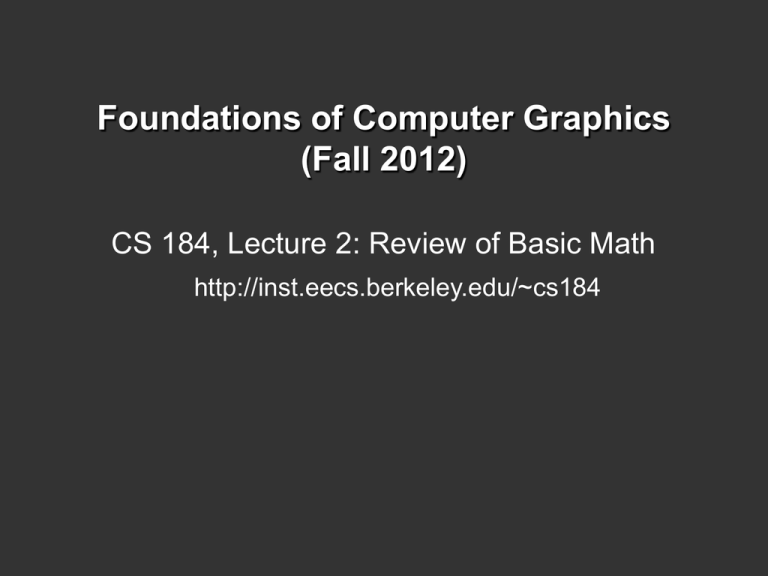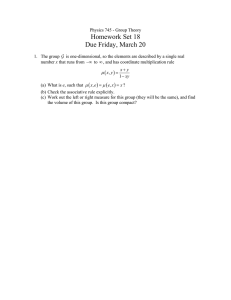Foundations of Computer Graphics (Fall 2012)
advertisement

Foundations of Computer Graphics (Fall 2012) CS 184, Lecture 2: Review of Basic Math http://inst.eecs.berkeley.edu/~cs184 To Do Complete Assignment 0 (a due 29, b due 31) Get help if issues with compiling, programming Textbooks: access to OpenGL references About first few lectures Somewhat technical: core math ideas in graphics HW1 is simple (only few lines of code): Lets you see how to use some ideas discussed in lecture, create images Motivation and Outline Many graphics concepts need basic math like linear algebra Vectors (dot products, cross products, …) Matrices (matrix-matrix, matrix-vector mult., …) E.g: a point is a vector, and an operation like translating or rotating points on object can be matrix-vector multiply Should be refresher on very basic material for most of you Only basic high school math required If you don’t understand, talk to me (review in office hours) Vectors = Usually written as a or in bold. Magnitude written as a Length and direction. Absolute position not important Use to store offsets, displacements, locations But strictly speaking, positions are not vectors and cannot be added: a location implicitly involves an origin, while an offset does not. Vector Addition b a Geometrically: Parallelogram rule In cartesian coordinates (next), simply add coords Cartesian Coordinates A=4X+3Y X X and Y can be any (usually orthogonal unit) vectors æ x ö A = ç ÷ è y ø A = T ( x y ) A = x +y 2 2 Vector Multiplication Dot product Cross product Orthonormal bases and coordinate frames Note: Some books talk about right and left-handed coordinate systems. We always use right-handed Dot (scalar) product b f a a ib = b ia = ? a ib = a b cosf a i(b + c) = a ib + a ic æ ö a ib -1 f = cos ç ÷ è a bø (ka) ib = a i(kb) = k(a ib) Dot product in Cartesian components æ x ö æ x ö a b ÷ ·ç ÷ =? a·b = ç çè y a ÷ø çè y b ÷ø æ x ö æ x ö a b ÷ ·ç ÷ = xa xb + y a y b a·b = ç çè y a ÷ø çè y b ÷ø Dot product: some applications in CG Find angle between two vectors (e.g. cosine of angle between light source and surface for shading) Finding projection of one vector on another (e.g. coordinates of point in arbitrary coordinate system) Advantage: computed easily in cartesian components Projections (of b on a) b f b®a =? b®a =? a a ib b ® a = b cosf = a a a ib b®a= b®a = a 2 a a Vector Multiplication Dot product Cross product Orthonormal bases and coordinate frames Note: Some books talk about right and left-handed coordinate systems. We always use right-handed Cross (vector) product a ´ b = -b ´ a a ´ b = a b sinf f b a Cross product orthogonal to two initial vectors Direction determined by right-hand rule Useful in constructing coordinate systems (later) Cross product: Properties x ´ y = +z y ´ x = -z y ´ z = +x z ´ y = -x z ´ x = +y x ´ z = -y a ´ b = -b ´ a a´a= 0 a ´ (b + c) = a ´ b + a ´ c a ´ (kb) = k(a ´ b) Cross product: Cartesian formula? x y z a ´ b = xa ya za xb yb zb æ 0 ç * a ´ b = A b = ç za ç çè -y a æ y z -y z a b b a ç = ç za xb - xa zb ç çè xa y b - y a xb -za 0 xa ö ÷ ÷ ÷ ÷ø y a ö æ xb ö ÷ç ÷ -xa ÷ ç y b ÷ ÷ç ÷ 0 ÷ø çè zb ÷ø Dual matrix of vector a Vector Multiplication Dot product Cross product Orthonormal bases and coordinate frames Note: book talks about right and left-handed coordinate systems. We always use right-handed Orthonormal bases/coordinate frames Important for representing points, positions, locations Often, many sets of coordinate systems (not just X, Y, Z) Global, local, world, model, parts of model (head, hands, …) Critical issue is transforming between these systems/bases Topic of next 3 lectures Coordinate Frames Any set of 3 vectors (in 3D) so that u = v = w =1 u iv = v iw = u iw = 0 w = u ´v p = (p iu)u + (p iv)v + (p iw)w Constructing a coordinate frame Often, given a vector a (viewing direction in HW1), want to construct an orthonormal basis Need a second vector b (up direction of camera in HW1) Construct an orthonormal basis (for instance, camera coordinate frame to transform world objects into in HW1) Constructing a coordinate frame? We want to associate w with a, and v with b But a and b are neither orthogonal nor unit norm And we also need to find u a w= a b´w u= b´w v =w ´u Matrices Can be used to transform points (vectors) Translation, rotation, shear, scale (more detail next lecture) What is a matrix Array of numbers (m×n = m rows, n columns) æ 1 3 ö ç ÷ ç 5 2 ÷ è 0 4 ø Addition, multiplication by a scalar simple: element by element Matrix-matrix multiplication Number of columns in first must = rows in second æ 1 3 ö ç ÷æ 3 6 9 4 ö ç 5 2 ÷ çè 2 7 8 3 ÷ø è 0 4 ø Element (i,j) in product is dot product of row i of first matrix and column j of second matrix Matrix-matrix multiplication Number of columns in first must = rows in second æ 1 3 ö æ 9 27 33 13 ö ç ÷æ 3 6 9 4 ö =ç ÷ ç 5 2 ÷ çè 2 7 8 3 ÷ø ç 19 44 61 26 ÷ è 0 4 ø è 8 28 32 12 ø Element (i,j) in product is dot product of row i of first matrix and column j of second matrix Matrix-matrix multiplication Number of columns in first must = rows in second æ 1 3 ö æ 9 27 33 13 ö ç ÷æ 3 6 9 4 ö ç ÷ ç 5 2 ÷ çè 2 7 8 3 ÷ø = ç 19 44 61 26 ÷ è 0 4 ø è 8 28 32 12 ø Element (i,j) in product is dot product of row i of first matrix and column j of second matrix Matrix-matrix multiplication Number of columns in first must = rows in second æ 1 3 ö æ 9 27 33 13 ö ç ÷æ 3 6 9 4 ö ç ÷ ç 5 2 ÷ çè 2 7 8 3 ÷ø = ç 19 44 61 26 ÷ è 0 4 ø è 8 28 32 12 ø Element (i,j) in product is dot product of row i of first matrix and column j of second matrix Matrix-matrix multiplication Number of columns in first must = rows in second æ 1 3 ö æ 3 6 9 4 öç ÷ 5 2 NOT EVEN LEGAL!! ç ÷ç ÷ è 2 7 8 3 øè 0 4 ø Non-commutative (AB and BA are different in general) Associative and distributive A(B+C) = AB + AC (A+B)C = AC + BC Matrix-Vector Multiplication Key for transforming points (next lecture) Treat vector as a column matrix (m×1) E.g. 2D reflection about y-axis æ -1 0 ö æ x ö æ -x ö ç ÷ç y ÷ =ç y ÷ è 0 1 øè ø è ø Transpose of a Matrix (or vector?) T æ 1 2 ö æ 1 3 5 ö ç ÷ ç 3 4 ÷ = çè 2 4 6 ÷ø è 5 6 ø (AB) = B A T T T Identity Matrix and Inverses I3´3 æ 1 0 0 ö ç ÷ =ç 0 1 0 ÷ è 0 0 1 ø -1 -1 AA = A A = I -1 -1 (AB) = B A -1 Vector multiplication in Matrix form Dot product? a · b = aT b æ x ö b ç ÷ xa y a za ç y b ÷ = xa xb + y a y b + za zb ç ÷ çè zb ÷ø Cross product? æ 0 -z öæ x ö y a a b ç ÷ ç ÷ * a ´ b = A b = ç za 0 -xa ÷ ç y b ÷ ç ÷ç ÷ çè -y a xa 0 ÷ø çè zb ÷ø ( ) ( Dual matrix of vector a )


